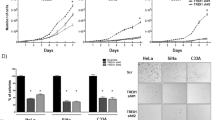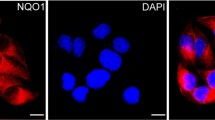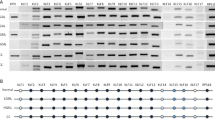Abstract
One of the subunits in the mammalian transcription factor II H complex, XPD (TFIIH p80), plays a significant role in the nucleotide excision repair pathway. Events such as abnormal DNA excision repair may be involved in the cervical carcinogenesis process. Expression of the human XPD protein was examined using immunohistochemistry in 84 normal cervical tissues and 148 cervical squamous cell carcinoma samples. Additionally, qRT-PCR was performed to analyse the XPD mRNA expression in 69 fresh normal cervical tissues and 110 cervical carcinoma samples. The relationships between XPD expression and various clinicopathological features (including age, FIGO stage, tumor size, stroma involvement, lymph node metastasis and histologic grade) were assessed. The XPD (TFIIH p80) protein was detected primarily in the cytoplasm. We found a statistically significant difference in XPD expression level in cervical carcinoma versus normal cervical tissue (Z = −7.302, P = 0.000). Notably, XPD mRNA was significantly over-expressed in cervical carcinoma tissues but not in normal cervix tissues (t = 6.942, P = 0.000). However, no statistically significant relationship was found regarding XPD expression and age, FIGO stage, tumor size, stroma involvement, lymph node metastasis or histologic grade (P = 0.089, 0.953, 0.809, 0.275, 0.421, 0.387 respectively). Our results showed that XPD was highly expressed in cervical squamous cell carcinoma tissues. A poorly understood change may occur during the XPD transcription process, resulting in the abnormal enrichment seen from mRNA to the protein level, thus leaving the protein unable to perform the normal function of excision repair. There is a need for further research in order to elucidate the specific mechanism involved.



Similar content being viewed by others
Abbreviations
- TFIIH:
-
Transcription factor II H complex
- XPD:
-
Xeroderma pigmentosum D
- qRT-PCR:
-
Quantitative Real-Time PCR
- FIGO:
-
International Federation of Gynecology and Obstetrics
- NER:
-
Nucleotide excision repair
- PBS:
-
Phosphate buffered saline
- CIN:
-
Cervical intraepithelial neoplasia
- HPV:
-
Human papillomavirus
- SNP:
-
Single-nucleotide polymorphism
References
Wang J, Lv XW, Shi JP et al (2007) Mechanisms involved in ceramide-induced cell cycle arrest in human hepatocarcinoma cells. World J Gastroenterol 13:1129–1134
Wang Y, Huang B, Edelmann L et al (2010) Genes essential for cell viability that are linked to tumor suppressor genes play a role in cancer susceptibility. Cell Cycle 9:3144–3145
Falik-Zaccai TC, Keren Z, Slor H (2009) The Versatile DNA Nucleotide Excision Repair (NER) and Its Medical Significance. Pediatr Endocrinol Rev 7:117–122
Li X, Urwyler O, Suter B (2010) Drosophila Xpd regulates Cdk7 localization, mitotic kinase activity, spindle dynamics, and chromosome segregation. PLoS Genet 6:e1000876
Aloyz R, Xu ZY, Bello V et al (2002) Regulation of cisplatin resistance and homologous recombinational repair by the TFIIH subunit XPD. Cancer Res 62:5457–5462
Chen J, Suter B (2003) Xpd, a structural bridge and a functional link. Cell Cycle 2:503–506
Chen J, Larochelle S, Li X et al (2003) Xpd/Ercc2 regulates CAK activity and mitotic progression. Nature 424:228–232
He X, Ye F, Zhang J et al (2008) Susceptibility of XRCC3, XPD, and XPG genetic variants to cervical carcinoma. Pathobiology 75:356–363
Tavana O, Benjamin CL, Puebla-Osorio N et al (2010) Absence of p53-dependent apoptosis leads to UV radiation hypersensitivity, enhanced immunosuppression and cellular senescence. Cell Cycle 9:3328–3336
Singh RP, Agarwal R (2006) Natural flavonoids targeting deregulated cell cycle progression in cancer cells. Curr Drug Targets 7:345–354
Marchisio M, Bertagnolo V, Lanuti P et al (2006) Nuclear protein kinase C-delta: a possible check-point of cell cycle progression. Int J Immunopathol Pharmacol 19:287–291
Mydlikova Z, Gursky J, Pirsel M (2010) Transcription factor IIH—the protein complex with multiple functions. Neoplasma 57:287–290
Zhovmer A, Oksenych V, Coin F (2010) Two sides of the same coin: TFIIH complexes in transcription and DNA repair. Scientific World Journal 10:633–643
Zurita M, Merino C (2003) The transcriptional complexity of the TFIIH complex. Trends in Genetics 19:578–584
Oksenych V, de Jesus BB, Zhovmer A et al (2009) Molecular insights into the recruitment of TFIIH to sites of DNA damage. Embo J 28:2971–2980
Jaitovich-Groisman I, Benlimame N, Slagle BL et al (2001) Transcriptional regulation of the TFIIH transcription repair components XPB and XPD by the hepatitis B virus x protein in liver cells and transgenic liver tissue. J Bio Chem 276:14124–14132
Oksenych V, Coin F (2010) The long unwinding road: XPB and XPD helicases in damaged DNA opening. Cell Cycle 9:90–96
Gao W, Romkes M, Zhong S et al (2010) Genetic polymorphisms in the DNA repair genes XPD and XRCC1, p53 gene mutations and bladder cancer risk. Oncol Rep 24:257–262
Sturgis EM, Zheng R, Li L et al (2000) XPD/ERCC2 polymorphisms and risk of head and neck cancer: a case–control analysis. Carcinogenesis 21:2219–2223
Butkiewicz D, Rusin M, Enewold L et al (2001) Genetic polymorphisms in DNA repair genes and risk of lung cancer. Carcinogenesis 22:593–597
Vogel U, Hedayati M, Dybdahl M et al (2001) Polymorphisms of the DNA repair gene XPD: correlations with risk of basal cell carcinoma revisited. Carcinogenesis 22:899–904
Long XD, Ma Y, Zhou YF et al (2009) XPD codon 312 and 751 polymorphisms, and AFB1 exposure, and hepatocellular carcinoma risk. BMC Cancer 9:400
Aboussekhra A, Biggerstaff M, Shivji MK et al (1995) Mammalian DNA nucleotide excision repair reconstituted with purified protein components. Cell 80:859–868
Acknowledgments
The authors are grateful to Ms. Minghua Yu for assistance in recruiting the subjects. This work was supported by a grant from the Zhejiang Natural Science Foundation of China (Y204049, Y2110200), from Science and Technology Project of Zhejiang Province, China (No.2005C23003), and from National Nature Science foundation of China (No.30973380).
Author Contribution Statement
FY and HC conceived and carried out experiments and analysed data. JJ conceived experiments and analysed data. CZ and QC carried out experiments. All authors contributed to the writing of the manuscript and had final approval of the submitted and published versions.
Conflict of Interest Statement
The authors have no conflicts of interest to declare.
Author information
Authors and Affiliations
Corresponding author
Rights and permissions
About this article
Cite this article
Ye, F., Jiao, J., Zhou, C. et al. Nucleotide Excision Repair Gene Subunit XPD is Highly Expressed in Cervical Squamous Cell Carcinoma. Pathol. Oncol. Res. 18, 969–975 (2012). https://doi.org/10.1007/s12253-012-9527-7
Received:
Accepted:
Published:
Issue Date:
DOI: https://doi.org/10.1007/s12253-012-9527-7




